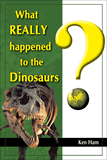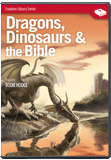
Dreadnoughtus Takes the Prize for Largest Confirmed Land Animal
News to Know
Abstract
Massive Dreadnoughtus said to shed light on the evolution of gigantism.
News Sources
The discovery of Dreadnoughtus schrani in southern Argentina’s Upper Cretaceous Patagonian plateau is big news because it may have been the largest terrestrial animal to have ever walked the Earth. And this “titanosaur”—a very large sauropod—wasn’t even full grown!
Drexel University paleontologist Kenneth Lacovara discovered the fossilized dinosaur and a somewhat smaller one beside it. Though the skull was not found, about 70% of all the kinds of its postcranial bones1 were recovered, including the ones paleontologists consider most important for estimating the body weight of four-legged animals—the humerus and the femur. Based on the smallest circumference of these two long bones, Lacovara says Dreadnoughtus has “the largest reliably calculable weight”2 for any land animal.
Big, Bigger, Biggest
Lacovara calculates Dreadnoughtus weighed about 65 tons. It was probably about 85 feet long.3 This weight is seven times the estimated weight of an adult T. rex and more than an adult sperm whale. Believed by evolutionists to be 77 million years old, this animal would have, as the BBC aptly explains, been longer than two London buses parked end to end.4 The tail alone was nearly 30 feet long, and its long neck is estimated at 37 feet!
“Dreadnoughtus was huge,” Lacovara says, “and in its environment there would have been nothing that could have preyed on it; it was essentially impervious to attack. And that evoked in my mind those turn-of-the-last-century battleships—the first really big steel battleships—that were also impervious to attack from the other ships that existed at that time. So, what better name than ‘dread nought’—‘fears nothing.’”4

Buried catastrophically during the global Flood, this 65-ton Dreadnoughtus is a testimony to the amazing creatures that roamed the pre-Flood world as well as the enormity of the Flood that buried it in the prime of life. Though representatives of all kinds of dinosaurs and other air-breathing land animals were preserved on the Ark, many, such as the dinosaurs, suffered extinction in the post-Flood world. Image from BBC.

This reconstruction of Dreadnoughtus shows the bones that were recovered in white. Scale bar = 1 meter. Image by L. Wright, with G. Schultz in “A Gigantic, Exceptionally Complete Titanosaurian Sauropod Dinosaur from Southern Patagonia, Argentina,” Scientific Reports.
Fragmentary Fossils
Previously discovered titanosaur fossils, such as Argentinosaurus found in Argentina earlier this year, have been very fragmentary and size estimates consequently suspect. Argentinosaurus was actually estimated at a much heavier 90 tons on the basis of a tibia, six vertebrae, and a few pieces of pelvis. Thus, Argentinosaurus might have been bigger in life than Dreadnoughtus, but there really isn’t enough left to know for sure.

This chart compares the mass of the massive Dreadnoughtus to a jet airplane and several other animals, extinct and extant. Image: BBC
Dreadnoughtus was evidently still growing when it was killed. Given that and the fragmentary nature of many fossil finds, it is difficult to know where to draw lines between species of dinosaurs. “When we look at one species and it appears to weigh 20 times more than another species, maybe what we're really looking at is an individual that is simply 30 years older than the other animal,” Lacovara explains. “Perhaps, what we are looking at are just growth series differences, rather than species or taxonomic differences. Certainly, just in terms of physiology, Dreadnoughtus, Argentinosaurus and some of the other big titanosaurs must have been approaching the limit of what was possible, but we don't know where that wall is.”4
Just a Juvenile

Paleontologists believe Dreadnoughtus was a fast-growing juvenile titanosaur at the time of its untimely death because bones in its shoulder remained unfused and because osteons—bone-making cells like those shown here in this well-vascularized section from the humerus—were abundant, very round, and lacked lines of arrested growth. Scale bar=1 mm. Image by K. Lacovara et al., “A Gigantic, Exceptionally Complete Titanosaurian Sauropod Dinosaur from Southern Patagonia, Argentina,” Scientific Reports.
How does Lacovara know Dreadnoughtus was a fast-growing juvenile? In living vertebrates, the growth plates in long bones are unfused in juveniles. Similarly, in dinosaurs, paleontologists find that fossils thought to be juveniles have unfused bones in the shoulder. Also the bone cells (osteons) visible under the microscope are fairly round in fossils of young dinosaurs but more oblong with “lines of arrested growth” in older animals. And dense accumulations of bone cells and well-vascularized bone suggest the bone was being actively remodeled as expected in a growing animal. Dreadnoughtus had lots of round osteons with no lines of arrested growth, and the bones in its shoulder remained unfused, suggesting it was still growing rapidly at the time of death.5
How did such an animal carry around such massive bulk? wonders London’s Natural History Museum paleontologist Paul Barrett. This discovery “finally gives some better insights into how these animals were actually built. It gives us the opportunity to understand things like the limits of bone strength, in terms of how you can hold up an animal of such immense size,” he says. “We can now start to think about modelling its breathing, its blood pressure and how much food it had to eat to get by. Once we know more about the overall proportions and shapes of these animals—and Dreadnoughtus is a big step in that direction—we can begin to unravel the secrets of titanosaur biology.”
Like other sauropods, Dreadnoughtus is thought to have consumed abundant plants in large quantities, able to reach plenty with its long neck and gulping them down without chewing, as suggested by the one peg-like tooth that was found. Paleontologists believe large sauropods like this didn’t have to worry about eating enough calories to generate the energy to keep warm—even if it were warm-blooded, which remains a matter of conjecture. On the contrary, an animal this large, models suggest, would have had a job keeping its body from overheating, needing to shed some of the heat generated through ordinary metabolic processes. The long neck and tail provided a lot of surface area through which heat could be shed. Additionally, Lacovara speculates during a BBC interview, Dreadnoughtus may have possessed an air-cooled system:
But it also has a very pneumatic skeleton in that there are a lot of air pockets and air sacs inside the skeleton that are connected to respiratory system so that when Dreadnoughtus took a breath of air in and exhaled it was also taking heat from nooks and crannies of its body and dumping it into the environment that way. So how could it get so big? Well it was living at a productive time in earth history and it was a superefficient animal.4
Some vertebrae in Dreadnoughtus contain little spaces. Some paleontologists believe such spaces are air sacs comparable to those in birds. These are found in other sauropod fossils too. However, whether these were actually air sacs, what functions they had, and especially whether or not they had any connection to the dinosaur respiratory system is purely a matter of conjecture. No such connection has been found in dinosaur fossils. The determination to relate dinosaur anatomy to bird anatomy is the source of most of the conjecture along these lines.6
Piecing together details of physiology from fossils will be tricky and necessitate a fair amount of guesswork. And conclusions are clearly at risk of being severely affected by evolutionary biases such as a supposed relationship between dinosaurs and birds! We do at least know from other Patagonian discoveries, however, that titanosaurs were egg-layers. In fact, we know that they started off life fairly small. Eggs of an armor-plated titanosaur species, Saltasaurus, were previously found in nests of about 25 eggs each, those eggs having diameters of only 4 to 5 inches. Thus, when God brought Noah two of each kind of dinosaur about 4,350 years ago, He would have certainly had smaller specimens than this great beast available to preserve the species through the global Flood on the Ark.
Catastrophically and Completely Buried
Dreadnoughtus was evidently struck down and rapidly buried in the prime of life. The titanosaur beside it suffered a similar fate. Lacovara says, “It appears that both individuals died and were buried rapidly after a river flooded and broke through its natural levee, turning the ground into a soupy mixture of sand, mud and water.”2
Lacovara says that there is a geologic reason most titanosaur fossils are so fragmentary:
To date all of the real giants that we’ve known about have only been known from very fragmentary remains. And there is a geologic reason for this: If you can imagine an animal the size of a house and that animal dying and keeling over on a hard flood plain somewhere at that moment very little of its body is in contact with the earth, so very little of its skeleton actually has the opportunity to enter the fossil record before it’s either scavenged or weathered away.4
Lacovara rightly acknowledges the necessity of rapid burial in the preservation of fossils. But what kind of river catastrophically destroyed and completely buried a couple of dinosaurs the size of two London buses? Another far more catastrophic source of water-borne sediment—sufficient to drop on these two strapping young dinosaurs like many tons of bricks—is easily found in the pages of the Bible’s book of Genesis chapters six through nine, a historical record of the Flood that catastrophically covered the Earth.
The fossil record contains a rich record of the rapid burial of billions of animals and the order in which they were swept away and sorted or simply buried where they stood. Only the application of worldview-based interpretations of scientific data interpret the geologic layers like those in which these dinosaurs were found as millions of years old.
Evolution of Giants
Of course it isn’t just how the huge animal’s physiology worked and how its anatomy had sufficient strength to sustain its bulk that paleontologists hope to learn from the fantastic find. They also expect to learn about the evolutionary history of gigantism. For instance, Lacovara and colleagues write, “It is presently uncertain whether extreme gigantism evolved multiple times or only once within Titanosauria.”7
Dreadnoughtus was a sauropod, and being so large it is considered a titanosaur. Evolutionary paleontologists believe the slightly smaller Jurassic sauropods like Diplodocus and Brachiosaurus were replaced by more evolved larger ones, the “titanosaurs,” in the late Cretaceous Period. Yet when the fossil record of the global Flood is properly understood as the order in which animals’ habitats were overwhelmed and in some cases fleeing animals finally engulfed by violently rising waters, these animals can be rightly understood not as an evolutionary progression over millions of years but a sequential burial record of animals that coexisted and were destroyed in a matter of days or weeks. Nothing about Dreadnoughtus reveals its evolutionary history, just a bit of its life history. It was a very large sauropod catastrophically struck down in the prime of life and rapidly buried in a manner most consistent with the catastrophic global Flood about 4,350 years ago.
Further Reading
- Lizard Breath Fails to Support Kinship with Birds
- Sauropod Enamel: Sign of Evacuation or Migration?
- Did Dinosaurs Turn into Birds?
- Sauropods Engineered for Size
- Cold-Blooded or Warm-Blooded?
- Dinosaur Teeth Hold Clues to Whether Species Was Warm or Cold-Blooded
- Dinosaurs May Have Been Neither Warm- Nor Cold-Blooded
For More Information: Get Answers
Remember, if you see a news story that might merit some attention, let us know about it! (Note: if the story originates from the Associated Press, FOX News, MSNBC, the New York Times, or another major national media outlet, we will most likely have already heard about it.) And thanks to all of our readers who have submitted great news tips to us. If you didn’t catch all the latest News to Know, why not take a look to see what you’ve missed?
(Please note that links will take you directly to the source. Answers in Genesis is not responsible for content on the websites to which we refer. For more information, please see our Privacy Policy.)
Footnotes
- Lacovara explains in a BBC interview that the completeness of a dinosaur skeleton can be described in terms of the absolute number of bones or in terms of the representative kinds of bones without worrying about missing left or right copies. (See Jonathan Amos, “‘Dreadnought’ Dinosaur Yields Big Bone Haul,” BBC News, September 4, 2014, http://www.bbc.com/news/science-environment-29050114.) He recovered about 45% of Dreadnoughtus’s total bones, or about 70% of the kinds of postcranial bones. By comparison, the next most complete titanosaur fossil is Futalognkosaurus, of which only 27% of the kinds of bones were recovered.
- Will Dunham, “Behemoth Argentine Dinosaur Dreadnoughtus made T. rex Look Puny,” Yahoo! News, September 4, 2014, news.yahoo.com/behemoth-argentine-dinosaur-dreadnoughtus-made-t-rex-look-142041824.html.
- Only a few cervical vertebrae were recovered, so the paleontologists could not determine the actual neck or, consequently, the entire body length. The vertebrae that were recovered resembled those of long-necked sauropods more than those of short-necked sauropods. Therefore, they estimate the neck at about 11.3 meters, or around 37 feet. This would make the entire body about 85 feet long. (Based on information from K. Lacovara et al., “A Gigantic, Exceptionally Complete Titanosaurian Sauropod Dinosaur from Southern Patagonia, Argentina,” Scientific Reports 4, no. 6196 (2014): doi:10.1038/srep06196.
- Amos, “‘Dreadnought’ Dinosaur Yields Big Bone Haul.”
- Lacovara and coauthors write: “Remarkably, multiple lines of evidence indicate that, despite its enormous size, MPM-PV 1156 was not osteologically mature at death. The scapula remains unfused to the coracoid, and the posteromedial margin of the coracoid foramen abuts the scapula; both of these morphologies have been cited as indicators of osteological immaturity in sauropods. Moreover, although histological analysis of the humerus indicates that its cortical bone has undergone extensive secondary remodelling, the element retains a thick layer of vascularized fibrolamellar bone between the remodelled inner cortex and the periphery of the periosteal surface. It also lacks lines of arrested growth or an external fundamental system, which may indicate osteological immaturity (although Company proposed this as a synapomorphy of Titanosauria rather than an indicator of ontogenetic stage). A similar pattern is observed in the dorsal ribs, which are extensively remodelled but retain primary fibrolamellar bone tissue towards the periosteal surface. Recent analyses have suggested that titanosaurs may have developed extensively remodelled tissues after reaching sexual maturity but prior to attaining their maximum size. Thus, the presence of unremodelled fibrolamellar bone in the outer cortex of the MPM-PV 1156 humerus suggests that this massive Dreadnoughtus individual was still growing at the time of its death.” From K. Lacovara et al., “A Gigantic, Exceptionally Complete Titanosaurian Sauropod Dinosaur from Southern Patagonia, Argentina,” Scientific Reports 4, no. 6196 (2014), doi:10.1038/srep06196.
-
A lengthy review paper by Michael Wedel (Mathew J. Wedel, “Vertebral Pneumaticity, Air Sacs, and the Physiology of Sauropod Dinosaurs,” Paleobiology 29, no. 2 (2003): 243–255) discussing the possible significance of spaces in the vertebrae of sauropods reveals, in fact clearly admits, the bias incurred through the effort to explain these bone spaces by relating them to bird respiratory systems. Wedel writes:
The vertebrae of sauropod dinosaurs are characterized by complex architecture involving laminae, fossae, and internal chambers of various shapes and sizes. These structures are interpreted as osteological correlates of a system of air sacs and pneumatic diverticula similar to that of birds.
In extant birds, diverticula of the cervical air sacs pneumatize the cervical and anterior thoracic vertebrae. Diverticula of the abdominal air sacs pneumatize the posterior thoracic vertebrae and synsacrum later in ontogeny. This ontogenetic sequence in birds parallels the evolution of vertebral pneumaticity in sauropods.
In basal sauropods, only the presacral vertebrae were pneumatized, presumably by diverticula of cervical air sacs similar to those of birds. The sacrum was also pneumatized in most neosauropods, and pneumatization of the proximal caudal vertebrae was achieved independently in Diplodocidae and Titanosauria.
Pneumatization of the sacral and caudal vertebrae in neosauropods may indicate the presence of abdominal air sacs.
Air sacs and skeletal pneumaticity probably facilitated the evolution of extremely long necks in some sauropod lineages by overcoming respiratory dead space and reducing mass.
In addition, pulmonary air sacs may have conveyed to sauropods some of the respiratory and thermoregulatory advantages enjoyed by birds, a possibility that is consistent with the observed rapid growth rates of sauropods.
The italicized portions (emphases ours) of this brief portion of Wedel’s paper highlight unverifiable worldview-based avian-associated assumptions not supportable by actual observational evidence in the dinosaur fossils themselves.
Learn more about the air sacs and respiration in birds and recent discoveries about the respiratory systems in lizards in “Lizard Breath Fails to Support Kinship with Birds.”
- K. Lacovara et al., “A Gigantic, Exceptionally Complete Titanosaurian Sauropod Dinosaur from Southern Patagonia, Argentina,” Scientific Reports 4, no. 6196 (2014), doi:10.1038/srep06196.
Recommended Resources

Answers in Genesis is an apologetics ministry, dedicated to helping Christians defend their faith and proclaim the good news of Jesus Christ.
- Customer Service 800.778.3390
- © 2024 Answers in Genesis





